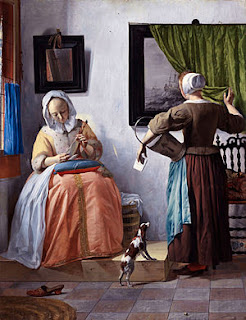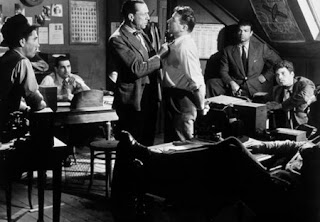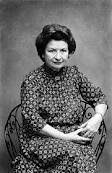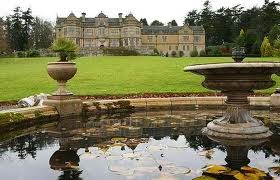No place like home
There's been a bit of a pause in blogging recently owing to family problems. So it was rather odd to be reading Judith Flanders' The making of home, a book about the development of what we, in the West at least, have come to think of as the standard elements that make a house "home".
Over the last 20 years I've been very exercised as to what is "home". After moving to Cambridge from S Wales, I lived in a series of rented accommodation. I soon gave up on thinking of any of it as "home" - way too unpredictable. Just when you thought this was where you were going to be for the next X number of years it ceased to become home - the landlord decided to sell, the landlady died, there was a change of use.
Finally settled into a home of my own, that too soon ceased to feel like home. Last year, I finally worked out that home was where the dogs were; and now, of course, there are no dogs, so I'm left feeling rather adrift again.
I enjoyed Judith Flanders' book, it was very enlightening, occasionally surprising, sometimes inaccurate, but a pleasure to read. Starting in Early Modern Europe, Flanders examines what our houses were originally intended for, and how they gradually evolved from being combination lodgings and businesses into the "Englishman's castle" of modern day life. Along the way there are some surprising insights into how the evolution of home also had an enormous impact (not necessarily positive) on women's lives. Many ideas that appeared to be labour-saving, for example, turned out to be more labour-saving for men than for women. The move to businesses outside the home meant that men had a journey to work but also enabled them to have a definite work "compartment" whereas the change for women meant that their work, and status as partners within the domestic relationship, was devalued while also forcing them to do more work within the home.
Some of the most fascinating parts of Flanders' book deal with the things that get left out of art. Our idea of the typical Flemish 16th/17th century home, for example, comes largely from the art of the period. We imagine Dutch homes as being airy and a little spartan. In fact many paintings are less about realism and more about iconography. Did you know that the lady in this painting by Gabriel Metsu, for example, would have been considered rather racy? The give-away is the cast-off shoe....
...or that this painting by Willem van Mieris is less about the austere beauty of the property than about the Low Countries emancipation from Spain? The canary bursting from its cage and the prominent broom sweeping Flanders free of the Spanish (spaniel) dog are the keys here. I'm delighted to see ancestors of my Alfie Spaniel appearing in both pictures too.
Flanders also points out that what you see in art work of any period is not necessarily what you would have actually seen in life. Until she mentioned it, I had never thought that it was odd that I had never seen a spittoon, for example, included in a picture of home, but if you think about modern representations of home, as Flanders perceptively points out, how often (if ever) do you see the miles of electrical cable that keep our TVs, chargers, satellite dishes, and fridges on the go?
Similarly many paintings of home are less about contemporary life as lived, and more about aspiration. Here though, I did have some disagreements with the author. Many of her assumptions were based upon early modern wills and other legal documents referring to household contents; although I'm sure that to a certain extent she was correct, I'm also sure that other documentation of the period might lead the researcher to believe otherwise. She mentioned, for example, the paucity of musical instruments. However only that week I had been doing some research on the Great Fire of London for another blog that I'm involved with, and had been struck by Samuel Pepys' observation:
Over the last 20 years I've been very exercised as to what is "home". After moving to Cambridge from S Wales, I lived in a series of rented accommodation. I soon gave up on thinking of any of it as "home" - way too unpredictable. Just when you thought this was where you were going to be for the next X number of years it ceased to become home - the landlord decided to sell, the landlady died, there was a change of use.
Finally settled into a home of my own, that too soon ceased to feel like home. Last year, I finally worked out that home was where the dogs were; and now, of course, there are no dogs, so I'm left feeling rather adrift again.
I enjoyed Judith Flanders' book, it was very enlightening, occasionally surprising, sometimes inaccurate, but a pleasure to read. Starting in Early Modern Europe, Flanders examines what our houses were originally intended for, and how they gradually evolved from being combination lodgings and businesses into the "Englishman's castle" of modern day life. Along the way there are some surprising insights into how the evolution of home also had an enormous impact (not necessarily positive) on women's lives. Many ideas that appeared to be labour-saving, for example, turned out to be more labour-saving for men than for women. The move to businesses outside the home meant that men had a journey to work but also enabled them to have a definite work "compartment" whereas the change for women meant that their work, and status as partners within the domestic relationship, was devalued while also forcing them to do more work within the home.
...or that this painting by Willem van Mieris is less about the austere beauty of the property than about the Low Countries emancipation from Spain? The canary bursting from its cage and the prominent broom sweeping Flanders free of the Spanish (spaniel) dog are the keys here. I'm delighted to see ancestors of my Alfie Spaniel appearing in both pictures too.
Flanders also points out that what you see in art work of any period is not necessarily what you would have actually seen in life. Until she mentioned it, I had never thought that it was odd that I had never seen a spittoon, for example, included in a picture of home, but if you think about modern representations of home, as Flanders perceptively points out, how often (if ever) do you see the miles of electrical cable that keep our TVs, chargers, satellite dishes, and fridges on the go?
Similarly many paintings of home are less about contemporary life as lived, and more about aspiration. Here though, I did have some disagreements with the author. Many of her assumptions were based upon early modern wills and other legal documents referring to household contents; although I'm sure that to a certain extent she was correct, I'm also sure that other documentation of the period might lead the researcher to believe otherwise. She mentioned, for example, the paucity of musical instruments. However only that week I had been doing some research on the Great Fire of London for another blog that I'm involved with, and had been struck by Samuel Pepys' observation:
River full of lighters and boats taking in goods, and good goods swimming in the water, and only I observed that hardly one lighter or boat in three that had the goods of a house in, but there was a pair of Virginalls in it.
Admittedly the people that Pepys spotted fleeing the fire were probably less the working-class of the City, and more the merchants and shopkeepers; the middle-class of 17th century London. Nevertheless, these were relatively ordinary people fleeing swiftly with the items that they most valued. They evidently desperately wanted to save their bits of furniture and the musical instruments that they loved.
The book is occasionally clunky, and there is some unfortunate and sometimes confusing chronological leaps around. Nevertheless though I found it a hugely informative and thought-provoking read. I'm not sure that I altogether agree with Flanders' premise that home in the sense that Dorothy in The Wizard of Oz thought of it - a place that is more about heart than head - is quite such a modern concept, but for a fascinating insight into how our contemporary perception of what makes a house "home" came into being The making of home is well worth a look.











Comments